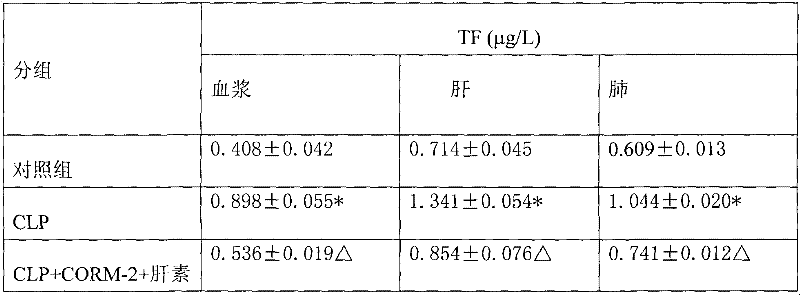Application of carbon monoxide-releasing molecules and heparin in preparing medicament for treating sepsis
A carbon monoxide and sepsis technology, used in the treatment of coagulation disorders in sepsis. Carbon monoxide releasing molecules combined with ultra-micro-dose heparin can solve problems such as coagulation damage and achieve easy and correct control of dosage and concentration. , to meet the effect of clinical application
- Summary
- Abstract
- Description
- Claims
- Application Information
AI Technical Summary
Problems solved by technology
Method used
Image
Examples
Embodiment 1
[0021] Preparation of the drug:
[0022] Mix 20.5 mg of carbon monoxide releasing molecules with 1 ml of DMSO to obtain a 40 mM preparation A, which is used at a dose of 8 mg / kg body weight; mix 20,000 IU / 2 ml of heparin with normal saline and dilute 10 times to obtain 1000 IU / L Heparin solution preparation B is used at a dose of 100IU / kg body weight.
Embodiment 2
[0024] The effects of CORM-2+ ultramicro-dose heparin on WBC, PLT count, plasminogen (PLG) and antithrombin III (AT-III) activities in septic mice.
[0025] experiment method:
[0026] (1) Animal and CLP sepsis models
[0027] Male C57BL / 6 mice, 6-8 weeks old, weighing 18±2 grams, are raised in ordinary laboratories (commercial dry block material, free drinking water). The experimental animals were divided into three groups according to the random number table method: Sham group (n=9), CLP group (n=9) and CLP+CORM-2+heparin group (n=9).
[0028] Under isoflurane inhalation anesthesia, mice in the CLP group underwent cecal ligation and perforation. After injury, 1.5ml normal saline was injected into the abdominal cavity for anti-shock; the mice in the CLP+CORM-2+heparin group were injected with CORM-2(8mg) after CLP. / kg), and at the same time intraperitoneal injection of heparin 100U / kg body weight.
[0029] Among them, the medicine used in the Sham group is normal saline, the medicin...
Embodiment 3
[0050] The effect of CORM-2+ ultra-micro-dose heparin on blood coagulation system and platelet aggregation in septic mice
[0051] experiment method:
[0052] (1) Animal and CLP sepsis models
[0053] Male C57BL / 6 mice, 6-8 weeks old, weighing 18±2 grams, are raised in ordinary laboratories (commercial dry block material, free drinking water). The experimental animals were divided into three groups according to the random number table method: Sham group (n=9), CLP group (n=9) and CLP+CORM-2+heparin group (n=9). Under isoflurane inhalation anesthesia, mice in CLP group underwent cecal ligation and perforation. After injury, 1.5ml normal saline was injected into the abdominal cavity for anti-shock; mice in CLP+CORM-2+heparin group were injected with CORM-2(8mg) after CLP. / kg), and at the same time intraperitoneal injection of heparin 100U / kg body weight. All animals were killed by inhalation of isoflurane 24 hours after injury, and specimens were collected.
[0054] (2) Testing indi...
PUM
 Login to View More
Login to View More Abstract
Description
Claims
Application Information
 Login to View More
Login to View More - R&D
- Intellectual Property
- Life Sciences
- Materials
- Tech Scout
- Unparalleled Data Quality
- Higher Quality Content
- 60% Fewer Hallucinations
Browse by: Latest US Patents, China's latest patents, Technical Efficacy Thesaurus, Application Domain, Technology Topic, Popular Technical Reports.
© 2025 PatSnap. All rights reserved.Legal|Privacy policy|Modern Slavery Act Transparency Statement|Sitemap|About US| Contact US: help@patsnap.com



